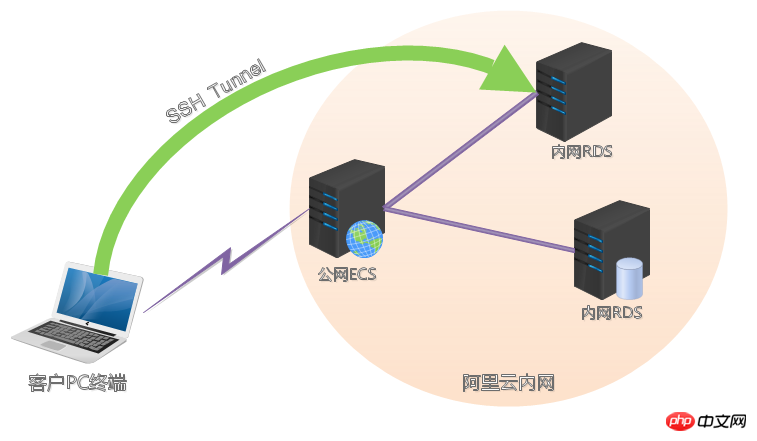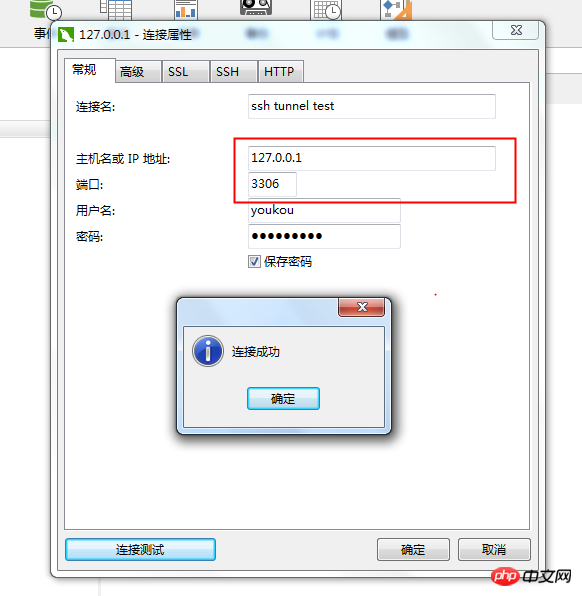 Operation and Maintenance
Operation and Maintenance
 Linux Operation and Maintenance
Linux Operation and Maintenance
 Detailed graphic and text steps for Linux to access intranet services through port forwarding
Detailed graphic and text steps for Linux to access intranet services through port forwarding
Detailed graphic and text steps for Linux to access intranet services through port forwarding
You can use port mapping to access services on the intranet ECS under the user name through the cloud server ECS with a public network. Other have not purchased public network bandwidth. There are many port mapping solutions, such as SSH Tunnel and rinetd under Linux, portmap under Windows, etc. This article briefly introduces rinetd and the configuration method of ssh tunnel.
Note: The relevant configurations and instructions in this article are only used as examples and operation guidelines. Alibaba Cloud is not responsible for the related operation results and resulting problems.
rinetd configuration method
If it is an Ubuntu system, you can directly use the following instructionsInstallation:
apt-get install rinetd -y
The source code installation and configuration method is introduced below. :
1. Download and decompress the rinetd package:
wget http://www.boutell.com/rinetd/http/rinetd.tar.gz&&tar -xvf rinetd.tar.gz&&cd rinetd
2. Modify the compilation configuration:
sed -i ‘s/65536/65535/g’ rinetd.c# 修改端口范围,否则会报错
3. Compile and install:
mkdir /usr/man&&make&&make install
4. Create Configuration file:
cat >>/etc/rinetd.conf <>/etc/rc.local # allow 192.168.2. # deny 192.168.1. # bindadress bindport connectaddress connectport0.0.0.0 3306 example.rds.aliyuncs.com 3306logfile /var/log/rinetd.logendecho rinetd >>/etc/rc.local
|
5. Use:
After rinetd is started, you can already connect to the example rds database in intranet mode through the 3306 port of the cloud server. Except for this scenario, other intranet port forwarding configurations are similar. However, since the FTP protocol port is random, forwarding cannot be achieved through this method.
In addition, a certain IP or IP segment can be allowed/denied in the configuration file, thereby improving the security of the intranet port.
SSH Tunnel configuration method
Establish an SSH tunnel between putty and the ECS with a public IP, and then use local port forwarding to implement intranet ECS on the customer PC terminal Direct access to RDS provides customers with great convenience for remote management.
The data flow direction is as follows: 
Preconditions
The customer PC terminal can log in to the ECS on the public network via ssh server.
An ECS server on the public network can access other intranet ECS servers through the intranet.
An ECS server with a public network can access RDS through the intranet (the intranet IP of ECS is in the whitelist of RDS).
Client configuration
1. Use putty on the client and fill in the IP and ssh port of the public ECS

2. Set up SSH Tunnel: Source Port is the local listening port of the PC, Destination fill in the intranet address and port of the intranet ECS server. Then click Add, a port forwarding record will be generated, and then click Open will open the SSH connection:

3. In In the pop-up window, enter normal SSH to log in to the ECS server with a public IP:

4. At this time, use the netstat –na command on the client PC terminal and you should see a Local monitoring of port 22 of 127.0.0.1:

5. By connecting to this local port, you can connect to the ECS server on the intranet:

6. This method is also applicable to Windows systems (in order not to conflict with the port of the client PC terminal, port 33389 is used as the local listening port)


7. RDS on the intranet can also be implemented:


8. Yes It is very convenient to directly use the database client program on the client PC terminal to connect to the database in RDS.

In addition, this function in SecureCRT is called Port forwarding , and the same function can be achieved after similar configuration.
The above is the detailed content of Detailed graphic and text steps for Linux to access intranet services through port forwarding. For more information, please follow other related articles on the PHP Chinese website!

Hot AI Tools

Undresser.AI Undress
AI-powered app for creating realistic nude photos

AI Clothes Remover
Online AI tool for removing clothes from photos.

Undress AI Tool
Undress images for free

Clothoff.io
AI clothes remover

Video Face Swap
Swap faces in any video effortlessly with our completely free AI face swap tool!

Hot Article

Hot Tools

Notepad++7.3.1
Easy-to-use and free code editor

SublimeText3 Chinese version
Chinese version, very easy to use

Zend Studio 13.0.1
Powerful PHP integrated development environment

Dreamweaver CS6
Visual web development tools

SublimeText3 Mac version
God-level code editing software (SublimeText3)

Hot Topics
 What computer configuration is required for vscode
Apr 15, 2025 pm 09:48 PM
What computer configuration is required for vscode
Apr 15, 2025 pm 09:48 PM
VS Code system requirements: Operating system: Windows 10 and above, macOS 10.12 and above, Linux distribution processor: minimum 1.6 GHz, recommended 2.0 GHz and above memory: minimum 512 MB, recommended 4 GB and above storage space: minimum 250 MB, recommended 1 GB and above other requirements: stable network connection, Xorg/Wayland (Linux)
 Linux Architecture: Unveiling the 5 Basic Components
Apr 20, 2025 am 12:04 AM
Linux Architecture: Unveiling the 5 Basic Components
Apr 20, 2025 am 12:04 AM
The five basic components of the Linux system are: 1. Kernel, 2. System library, 3. System utilities, 4. Graphical user interface, 5. Applications. The kernel manages hardware resources, the system library provides precompiled functions, system utilities are used for system management, the GUI provides visual interaction, and applications use these components to implement functions.
 vscode terminal usage tutorial
Apr 15, 2025 pm 10:09 PM
vscode terminal usage tutorial
Apr 15, 2025 pm 10:09 PM
vscode built-in terminal is a development tool that allows running commands and scripts within the editor to simplify the development process. How to use vscode terminal: Open the terminal with the shortcut key (Ctrl/Cmd). Enter a command or run the script. Use hotkeys (such as Ctrl L to clear the terminal). Change the working directory (such as the cd command). Advanced features include debug mode, automatic code snippet completion, and interactive command history.
 How to run java code in notepad
Apr 16, 2025 pm 07:39 PM
How to run java code in notepad
Apr 16, 2025 pm 07:39 PM
Although Notepad cannot run Java code directly, it can be achieved by using other tools: using the command line compiler (javac) to generate a bytecode file (filename.class). Use the Java interpreter (java) to interpret bytecode, execute the code, and output the result.
 How to check the warehouse address of git
Apr 17, 2025 pm 01:54 PM
How to check the warehouse address of git
Apr 17, 2025 pm 01:54 PM
To view the Git repository address, perform the following steps: 1. Open the command line and navigate to the repository directory; 2. Run the "git remote -v" command; 3. View the repository name in the output and its corresponding address.
 Where to write code in vscode
Apr 15, 2025 pm 09:54 PM
Where to write code in vscode
Apr 15, 2025 pm 09:54 PM
Writing code in Visual Studio Code (VSCode) is simple and easy to use. Just install VSCode, create a project, select a language, create a file, write code, save and run it. The advantages of VSCode include cross-platform, free and open source, powerful features, rich extensions, and lightweight and fast.
 What is the main purpose of Linux?
Apr 16, 2025 am 12:19 AM
What is the main purpose of Linux?
Apr 16, 2025 am 12:19 AM
The main uses of Linux include: 1. Server operating system, 2. Embedded system, 3. Desktop operating system, 4. Development and testing environment. Linux excels in these areas, providing stability, security and efficient development tools.
 vscode terminal command cannot be used
Apr 15, 2025 pm 10:03 PM
vscode terminal command cannot be used
Apr 15, 2025 pm 10:03 PM
Causes and solutions for the VS Code terminal commands not available: The necessary tools are not installed (Windows: WSL; macOS: Xcode command line tools) Path configuration is wrong (add executable files to PATH environment variables) Permission issues (run VS Code as administrator) Firewall or proxy restrictions (check settings, unrestrictions) Terminal settings are incorrect (enable use of external terminals) VS Code installation is corrupt (reinstall or update) Terminal configuration is incompatible (try different terminal types or commands) Specific environment variables are missing (set necessary environment variables)






